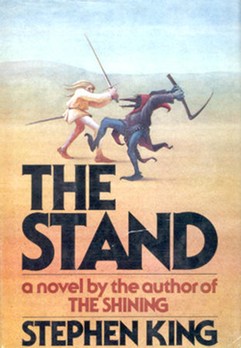The Stand was a landmark book for Stephen King, and not just because it’s the approximate size and weight of an actual landmark. It was the book that ended his contract with Doubleday and landed him his first agent, turning Stephen King from rich author into a very, very rich author. But, more importantly from a writing point of view, there is one detail that made it tower above everything else Stephen King had written up until that point, one factor that made The Stand special. And that factor? Simple: it was long. M-O-O-N long. And that’s more important than you might think.
After finishing The Shining, King took a month off before he started on his next book, The House on Value Street. A fictionalized account of the Patty Hearst kidnapping, King believed that only a novelist could make sense of Hearst’s kidnapping and induction into the Symbionese Liberation Army. However, after six weeks of work nothing was coming and, even worse for a character-based writer like King, his characters felt lifeless and borrowed from other books. Sitting at his dead typewriter, surrounded by his research materials, he found himself thinking about the 1968 Dugway incident, in which an Army test of nerve gas in Utah accidentally killed 3,000 sheep, and also about George R. Stewart’s book, Earth Abides, concerning a pandemic that wipes out mankind, and also about a line overheard on a late night Christian radio station “Once in every generation the plague will fall among them.” These three ideas swirled in his mind and collided with his concept of the Dark Man, Randall Flagg, based on SLA kidnapper Donald DeFreeze. Almost like automatic writing, he began typing a few sentences and, two years later, The Stand was born.
King described The Stand as his very own Vietnam, an endless conflict that he sometimes hated, but could never seem to finish. It took him two years to write, and in the meantime he had to placate his hungry publisher, Doubleday, with Night Shift when they came calling for another novel. King took his time with The Stand and when he was finished he was exceedingly proud of it. The book “seems to sum up everything I had to say up until that point,” King said in an interview. It was exactly what he wanted: an epic of epic epicness. “I wanted to do The Lord of the Rings with an American background,” he claimed in a later interview, going on to say that this kind of ambition was something he wasn’t previously willing to acknowledge in case the book turned out to be a disaster. And in the beginning, there was every sign that it would be.
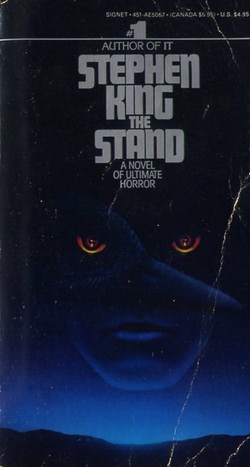 The Stand was originally closer to 1200 pages, but Doubleday’s presses could only accommodate an 800-ish page book, so his editor gave King an ultimatum: they would not accept his manuscript unless it was cut by a third. He could cut 400 pages himself, or they would. King chose to make the cuts himself, but this was the straw that broke the camel’s back. The Stand was the last book he owed Doubleday on his contract, and immediately after it came out he hired an agent, Kirby McCauley, and demanded a three-book $3.5 million deal. Doubleday refused to go above $3 million, which may have been what King was hoping for. He had been complaining for a while that Doubleday disrespected him despite the vast sacks of cash he earned them and so, in a move orchestrated by McCauley, he walked to New American Library, his paperback publisher (who started licensing his hardcover rights to Viking). In seeming retaliation, Doubleday fired Bill Thompson, the editor who had discovered King and who had been his strongest advocate at the house. It’s a classic battle between author and publisher, and this one would have repercussions for years to come, resulting in King’s 1983 book, Pet Sematary.
The Stand was originally closer to 1200 pages, but Doubleday’s presses could only accommodate an 800-ish page book, so his editor gave King an ultimatum: they would not accept his manuscript unless it was cut by a third. He could cut 400 pages himself, or they would. King chose to make the cuts himself, but this was the straw that broke the camel’s back. The Stand was the last book he owed Doubleday on his contract, and immediately after it came out he hired an agent, Kirby McCauley, and demanded a three-book $3.5 million deal. Doubleday refused to go above $3 million, which may have been what King was hoping for. He had been complaining for a while that Doubleday disrespected him despite the vast sacks of cash he earned them and so, in a move orchestrated by McCauley, he walked to New American Library, his paperback publisher (who started licensing his hardcover rights to Viking). In seeming retaliation, Doubleday fired Bill Thompson, the editor who had discovered King and who had been his strongest advocate at the house. It’s a classic battle between author and publisher, and this one would have repercussions for years to come, resulting in King’s 1983 book, Pet Sematary.
At first glance, The Stand isn’t a very promising book. Suffused with more than a little Bruce Springsteen, from its blue collar poetry singing the praises of small town America to the fact that the title is taken from Springsteen’s song “Jungleland,” it has an almost childishly schematic plot. When the military accidentally unleash a biological weapon (nicknamed “Captain Trips”) it wipes out America (the rest of the world is disposed of in one short chapter in which the military spreads the virus around the world in an act reminiscent of the Mutually Assured Destruction doctrine). A few thousand Americans are naturally immune to the plague, and the book follows several of them as they dig themselves out of the rubble. Guided by prophetic dreams, the nice survivors congregate on a farm owned by Mother Abigail, a saintly, 108-year-old African-American woman who leads them to establish the Boulder Free Zone. Meanwhile, the mean characters are drawn to Randall Flagg, the evil Dark Man, and they set up camp in Las Vegas.
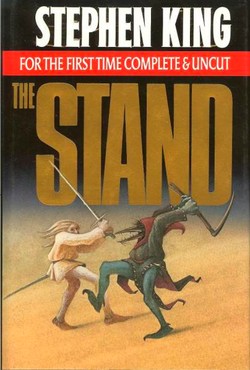 The rest of the book follows the fellowship of the faith-based Free Zoners who set off on a mystical quest to destroy the technocratic Las Vegas crew who are arming jet fighters and unearthing nukes, led by Flagg who wants to have a baby and rule the world. In the end, the “Hand of God” touches off a nuclear device in Las Vegas and everyone there dies. The final 60 pages are something very much like the end of Tolkien’s Return of the King, as three of the heroes (two men and one dog) struggle back home to Boulder after their adventures are over. However, they find home so changed, or they themselves are so changed by their quest, that they have to leave it behind and strike out for wilder territory to truly be at peace.
The rest of the book follows the fellowship of the faith-based Free Zoners who set off on a mystical quest to destroy the technocratic Las Vegas crew who are arming jet fighters and unearthing nukes, led by Flagg who wants to have a baby and rule the world. In the end, the “Hand of God” touches off a nuclear device in Las Vegas and everyone there dies. The final 60 pages are something very much like the end of Tolkien’s Return of the King, as three of the heroes (two men and one dog) struggle back home to Boulder after their adventures are over. However, they find home so changed, or they themselves are so changed by their quest, that they have to leave it behind and strike out for wilder territory to truly be at peace.
“I was suffering from a really good case of career jet lag,” King writes about the two years in which he wrote The Stand. “Four years before, I had been running sheets in an industrial laundry for $1.60 an hour and writing Carrie in the furnace-room of a trailer. Suddenly, all of my friends thought I was rich. That was bad enough, scary enough; what was worse was the fact that maybe I was. People began to talk to me about investments, about tax shelters, about moving to California. These were changes enough to try and cope with, but on top of them, the America I had grown up in seemed to be crumbling beneath my feet….”
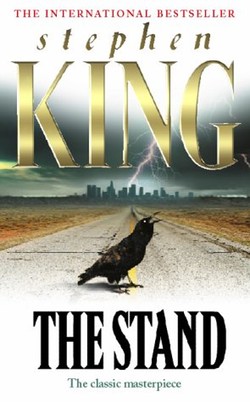 Beset by financial and lifestyle complications he had never dreamed of—from what to do with all his money to how to cope with the growing legions of Number One Fans—King was also living in a world with rising inflation and gas prices, random terrorist attacks, Legionnaire’s disease killing 34 people in a Philadelphia hotel, and a blackout that left New York City dark for over 24 hours, resulting in riots and looting. It was a complicated life for a guy who’d been living in a trailer five years previously, a complicated life lived in a complicated world that was seemingly getting more complicated by the minute. Unable to fix this complicated, interconnected, tangled up world, King did the next best thing: he wiped it out and started over. You can feel the great relish King took in burning it all down in The Stand. The sheer joy of unbridled destruction rings throughout the first half of the book, most notably in a long chapter where Trashcan Man, a pyromaniac and mechanical savant, torches some oil tanks and sets an entire town on fire.
Beset by financial and lifestyle complications he had never dreamed of—from what to do with all his money to how to cope with the growing legions of Number One Fans—King was also living in a world with rising inflation and gas prices, random terrorist attacks, Legionnaire’s disease killing 34 people in a Philadelphia hotel, and a blackout that left New York City dark for over 24 hours, resulting in riots and looting. It was a complicated life for a guy who’d been living in a trailer five years previously, a complicated life lived in a complicated world that was seemingly getting more complicated by the minute. Unable to fix this complicated, interconnected, tangled up world, King did the next best thing: he wiped it out and started over. You can feel the great relish King took in burning it all down in The Stand. The sheer joy of unbridled destruction rings throughout the first half of the book, most notably in a long chapter where Trashcan Man, a pyromaniac and mechanical savant, torches some oil tanks and sets an entire town on fire.
But there was a plotting problem. When the world ends there will be ample resources for the survivors, so how could he provoke his characters into doing something interesting? Post-plague, the population would be scattered and probably amble along for a bit, maybe with a few mutant biker gangs here and there stirring up trouble, but there would be no overwhelming imperative for people to come together and engage in conflict. And that was a problem because King didn’t want his apocalypse to be pokey, he wanted his apocalypse to be an epic about the war for the souls of the survivors. His solution was to deploy that laziest of literary devices: dreams.
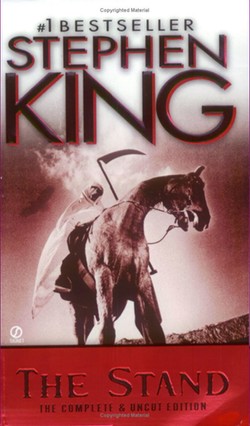 The organizing principle of the second half of the book wasn’t the plague, but the dreams, good and bad, that drew “good” survivors to Boulder and “bad” survivors to Las Vegas, spurring them into action when the more natural response might be to stay put. This becomes habitual in The Stand—whenever the plot started falling into a rut, King goosed it along with some kind of quasi-mystical, out-of-left-field intervention. Whether it’s Mother Abigail’s disappearance, Trashcan Man unearthing a nuke, Mother Abigail suddenly sending the main characters on a quest, Nadine deciding to leave the Free Boulder Zone to have a baby with Flagg, or Harold setting a bomb, it feels like the hand of god is constantly poking these characters into motion. Even the end of the book is a literal deus ex machina, with the “Hand of God” actually appearing and setting off a nuke.
The organizing principle of the second half of the book wasn’t the plague, but the dreams, good and bad, that drew “good” survivors to Boulder and “bad” survivors to Las Vegas, spurring them into action when the more natural response might be to stay put. This becomes habitual in The Stand—whenever the plot started falling into a rut, King goosed it along with some kind of quasi-mystical, out-of-left-field intervention. Whether it’s Mother Abigail’s disappearance, Trashcan Man unearthing a nuke, Mother Abigail suddenly sending the main characters on a quest, Nadine deciding to leave the Free Boulder Zone to have a baby with Flagg, or Harold setting a bomb, it feels like the hand of god is constantly poking these characters into motion. Even the end of the book is a literal deus ex machina, with the “Hand of God” actually appearing and setting off a nuke.
The incessant meddling from on high is one of the weaknesses of The Stand, but the more serious problem is its tendency to engage in simplistic dualism, a dividing of the world into black and white, good and evil, nice and mean. There are the good guys in Boulder, and the bad guys in Vegas. There is a nice old lady and a mean old Nixon stand-in (although Flagg was based on a militant radical, he comes to resemble Tricky Dick far more, willing to say anything to gain power, but ultimately insubstantial). There are people who believe in prayer and people who believe in technology. It doesn’t help that the characters, when the book starts, are cardboard thin. Fran is a nice, practical pregnant girl. Stu Redman is a salt of the earth type. Larry Underwood is a selfish rock star. Harold Lauder is an evil lech. Mute, noble Nick Andros is an inspiration. For people who don’t make it past the first 200 pages, The Stand is ‘Salem’s Lot all over again, only longer. Stop the book at page 200 and you’ve got cardboard cut-outs being moved around a chessboard by the all-too-obvious hand of the author, disguised as the hand of god.
But as The Stand gets longer its characters get deeper simply through virtue of the fact that they have to appear in so many scenes. King gives his characters the room on the page they need to surprise him, and in doing so they surprise the reader. By the end of The Stand, Nick Andros has become a cold manipulator, Stu is a waffler, Harold finds satisfaction in hard work and seriously considers reforming himself, and Larry Underwood goes from yellow belly to hero. Even saintly Mother Abigail falls from grace due to her pride, echoing the story of Moses forbidden to enter the Promised Land.
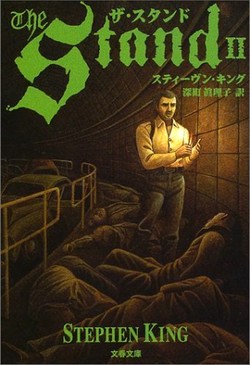 The Stand is a book where the epic length works in King’s favor, and he uses it not so much for giant set pieces (most of the book consists of people either riding motorcycles or sitting around talking) but to let his characters age, ripen, and mature beyond their initial stereotypes. Stop the book too early and it’s thin, simplistic, and way too long. But read it all the way through and you will find that it operates on the same principle that has made HBO’s dramas so good: give good dramatists all the room they want, over a long period of time, and they’ll give you characters who feel real. The Stand may be long, but King needs all those pages to let his fictional characters convincingly grow a third dimension. Some writers could do it quicker, but King seems to need the pages. What’s more, it’s this length that allows his book to come close to transcending genre.
The Stand is a book where the epic length works in King’s favor, and he uses it not so much for giant set pieces (most of the book consists of people either riding motorcycles or sitting around talking) but to let his characters age, ripen, and mature beyond their initial stereotypes. Stop the book too early and it’s thin, simplistic, and way too long. But read it all the way through and you will find that it operates on the same principle that has made HBO’s dramas so good: give good dramatists all the room they want, over a long period of time, and they’ll give you characters who feel real. The Stand may be long, but King needs all those pages to let his fictional characters convincingly grow a third dimension. Some writers could do it quicker, but King seems to need the pages. What’s more, it’s this length that allows his book to come close to transcending genre.
Terence Rafferty writing for the Times Book Review wrote that the key difference between genre and literary fiction was that literary fiction “allows itself to dawdle, to linger on stray beauties even at the risk of losing its way.” If that can be accepted as a working definition, then King is rapidly leaving genre behind. Although The Lord of the Rings provided the template for The Stand, it’s the moments of the book that linger on extraneous details that make it memorable.
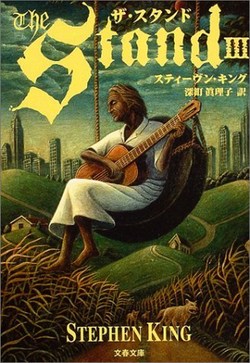 Larry Underwood’s flight through the pitch dark Lincoln Tunnel is an extended nightmare that didn’t need to be written, the very definition of a “stray beauty.” So is the chapter in which Fran Underwood struggles to bury her father. Or Mother Abigail’s chapter in which she spends all day fetching chickens and fighting weasels. There are long sections told from the point-of-view of one character or another that are simply unnecessary to the needs of genre: Trashcan Man lighting Powtanville on fire, Lloyd Henreid sitting in his prison cell for days on end, Nadine vacillating over what kind of person she wants to be. None of these chapters drive the plot forward, but they do deepen the characters. In fact, given the book’s preoccupation with fireside chit chat, picnics, and long walks, it feels tremendously relaxed for what could, in lesser hands, be just another thriller.
Larry Underwood’s flight through the pitch dark Lincoln Tunnel is an extended nightmare that didn’t need to be written, the very definition of a “stray beauty.” So is the chapter in which Fran Underwood struggles to bury her father. Or Mother Abigail’s chapter in which she spends all day fetching chickens and fighting weasels. There are long sections told from the point-of-view of one character or another that are simply unnecessary to the needs of genre: Trashcan Man lighting Powtanville on fire, Lloyd Henreid sitting in his prison cell for days on end, Nadine vacillating over what kind of person she wants to be. None of these chapters drive the plot forward, but they do deepen the characters. In fact, given the book’s preoccupation with fireside chit chat, picnics, and long walks, it feels tremendously relaxed for what could, in lesser hands, be just another thriller.
Carrie was a gothic portrait of an individual, while ‘Salem’s Lot gave readers a large collection of two-dimensional characters engaged in an epic battle. The Shining tightened the focus to four characters and allowed at least one of them, Jack Torrance, to come to life in all his contradictions. The Stand combines the character work of The Shining with the plot-heavy sprawl of ’Salem’s Lot to deliver a character-based epic. So of course it’s long. To write a book where this many characters make choices that affect their destinies, act contrary to their own best interests, and whose inner lives don’t match their outer, King needed a lot of pages.
Later King would be mocked for the length of his books, and too often in his later career he would seemingly spin his wheels, burning page after page while not telling the reader anything new. A good case in point is the addition of 400 pages to a new edition of The Stand released in 1990 that didn’t so much add to its charms as bury them under even more words. But in the first version of The Stand the length is just long enough to allow King to let his characters stretch their legs for as long as it takes them to come alive in his mind. It’s the book where he acquired an agent and walked to another publishing house, a tough move for any author. Starting here, King would take all the time he needed to get his characters right, for as many pages as it took. The Stand was the book where he realized he had the power to demand as many of those pages as he wanted.










